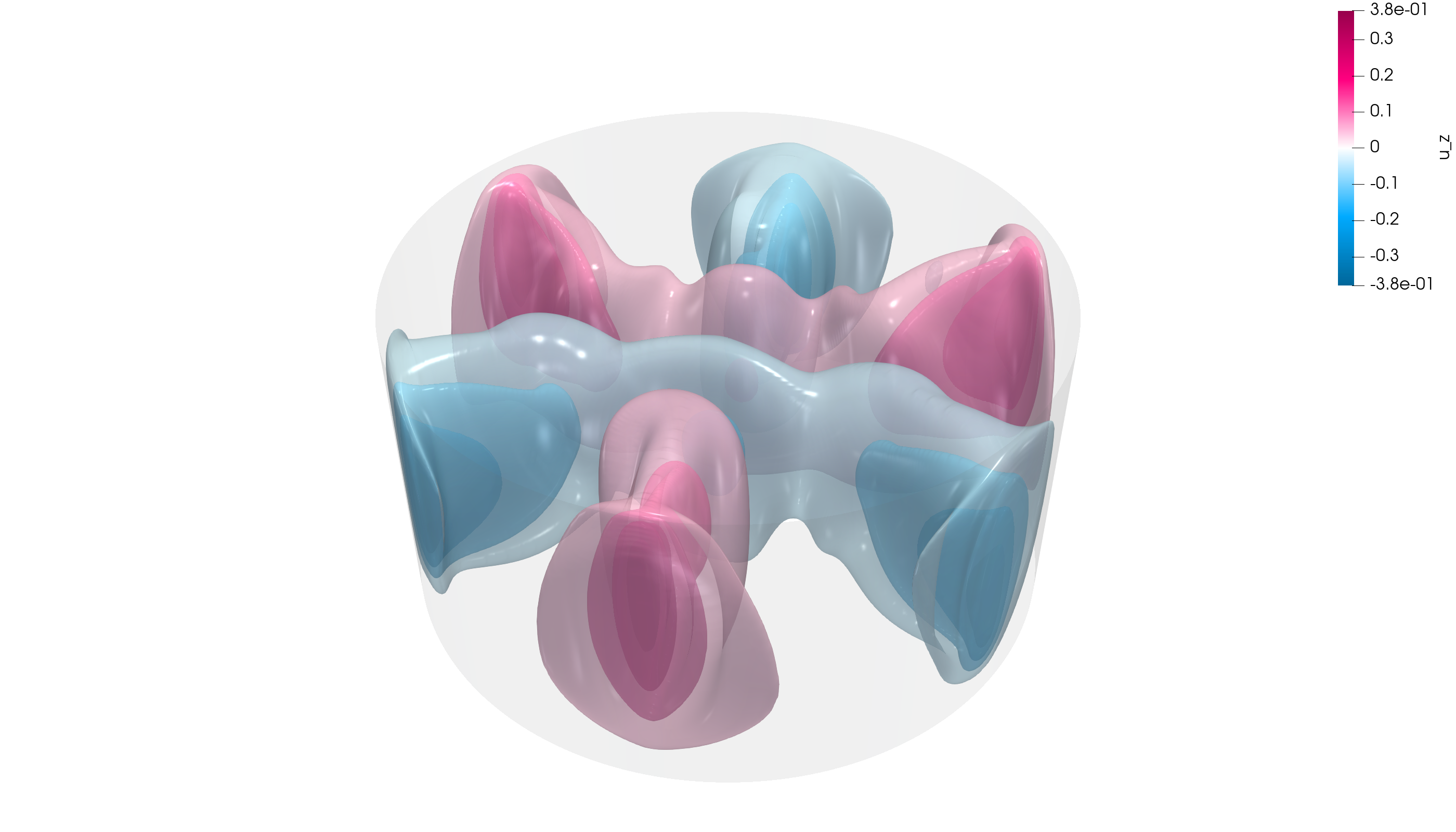Horn, S., Schmid, P.J. & Aurnou, J.M. (2022) Unravelling the large-scale circulation modes in turbulent Rayleigh–Bénard convection. Europhys. Lett. 136, 14003, https://doi.org/10.1209/0295-5075/ac3da2 invited article for the focus issue of EPL on “Turbulent Thermal Convection”
Aggarwal, A., Aurnou, J. M. & Horn, S. (2022) Magnetic damping
of jet flows in quasi-two-dimensional Rayleigh-Bénard convection. Phys. Rev. E 106, 045104, https://doi.org/10.1103/PhysRevE.106.045104
Grannan, A. M., Cheng, J. S., Aggarwal, A., Hawkins, E. K., Xu, Y., Horn, S., Sánchez-Álvarez, J. & Aurnou, J. M. (2022) Experimental pub crawl from Rayleigh–Bénard to magnetostrophic convection. J. Fluid Mech. 939, R1, https://www.doi.org/10.1017/jfm.2022.204
featured in Focus on Fluids (JFM), written by Jörg Schumacher, https://doi.org/10.1017/jfm.2022.455
Akashi, M., Yanagisawa, T., Sakuraba, A., Schindler, F., Horn, S., Vogt, T. & Eckert, S. (2022) Jump rope vortex flow in liquid metal Rayleigh–Bénard convection in a cuboid container of aspect ratio five. J. Fluid Mech. 932, A27, https://doi.org/10.1017/jfm.2021.996
Xu, Y., Horn, S. & Aurnou, J. M. (2022) Thermoelectric precession in turbulent magnetoconvection. J. Fluid Mech. 930, A8, https://doi.org/10.1017/jfm.2021.880
Horn, S. & Aurnou, J.M. (2021) Tornado-like vortices in the quasi-cyclostrophic regime of Coriolis-centrifugal convection. J. Turbul. 22 (4-5), 297–324, https://doi.org/10.1080/14685248.2021.1898624
Vogt, T., Horn, S. & Aurnou, J.M. (2021) Oscillatory thermal–inertial flows in liquid metal rotating convection. J. Fluid Mech. 911, A5, https://doi.org/10.1017/jfm.2020.976
Aurnou, J. M., Horn, S. & Julien, K. (2020) Connections between non-rotating, slowly rotating, and rapidly rotating turbulent convection transport scalings. Phys. Rev. Res. 2, 043115, https://doi.org/10.1103/PhysRevResearch.2.043115
Zhang, X., van Gils, D.P.M., Horn, S., Wedi, M., Zwirner, L., Ahlers, G., Ecke, R.E., Weiss, S., Bodenschatz, E. & Shishkina, O. (2020) Boundary Zonal Flow in Rotating Turbulent Rayleigh-Bénard Convection. Phys. Rev. Lett. 124 (8), 084505, https://doi.org/10.1103/PhysRevLett.124.084505
Horn, S. & Aurnou, J.M. (2019) Rotating convection with centrifugal buoyancy: Numerical predictions for laboratory experiments. Phys. Rev. Fluids 4, 073501, https://doi.org/10.1103/PhysRevFluids.4.073501
Vogt, T., Horn, S., Grannan, A.M. & Aurnou, J.M. (2018) Jump Rope Vortex in Liquid Metal Convection. Proc. Natl. Acad. Sci. 115, 12674–12679, https://doi.org/10.1073/pnas.1812260115, co-first authorship
Horn, S. & Aurnou, J.M. (2018) Regimes of Coriolis-Centrifugal Convection. Phys. Rev. Lett. 120, 204502, https://doi.org/10.1103/PhysRevLett.120.204502
featured Focus article in the German Physik Journal, written by Stephan Stellmach
Aurnou, J.M., Bertin, V., Grannan, A.M., Horn, S. & Vogt, T. (2018) Rotating thermal convection in liquid gallium: Multi-modal flow absent steady columns. J. Fluid Mech. 846, 846–876, https://doi.org/10.1017/jfm.2018.292
Kooij, G.L., Botchev, M.A., Frederix E.M.A., Geurts, B.J., Horn, S., Lohse, D., van der Poel, E.P., Shishkina, O., Stevens, R.J.A.M. & Verzicco, R. (2018) Comparison of computational codes for direct numerical simulations of turbulent Rayleigh-Bénard convection. Comp. & Fluids 166, 1–8, https://doi.org/10.1016/j.compfluid.2018.01.010
Horn, S. & Schmid, P.J. (2017) Prograde, retrograde and oscillatory modes in rotating Rayleigh–Bénard convection. J. Fluid Mech. 831, 182–211, https://doi.org/10.1017/jfm.2017.631
Shishkina, O., Horn, S., Emran, M.S. & Ching, E.S.C. (2017) Mean Temperature Profiles in Turbulent Thermal Convection. Phys. Rev. Fluids 2 (11), 113502, https://doi.org/10.1103/PhysRevFluids.2.113502
Shishkina, O. & Horn, S. (2016) Thermal convection in inclined cylindrical containers. J. Fluid Mech. 790, R3, https://doi.org/10.1017/jfm.2016.55
Horn, S. & Shishkina, O. (2015) Toroidal and poloidal energy in rotating Rayleigh–Bénard convection. J. Fluid Mech. 762, 232–255, https://doi.org/10.1017/jfm.2014.652
Shishkina, O., Horn, S., Wagner, S. & Ching, E.S.C. (2015) Thermal Boundary Layer Equation for Turbulent Rayleigh–Bénard Convection. Phys. Rev. Lett. 114 (11), 114302, https://doi.org/10.1103/PhysRevLett.114.114302
Horn, S. & Shishkina, O. (2014) Rotating non-Oberbeck–Boussinesq Rayleigh–Bénard convection in water. Phys. Fluids 26, 055111, https://doi.org/10.1063/1.4878669
featured article on the cover of Physics of Fluids
Shishkina, O., Wagner, S. & Horn, S. (2014) Influence of the angle between the wind and the isothermal surfaces on the boundary layer structures in turbulent thermal convection. Phys. Rev. E 89 (3), 033014, https://doi.org/10.1103/PhysRevE.89.033014
selected for the Kaleidoscope of Phys. Rev. E, March 2014
Shishkina, O., Horn, S. & Wagner, S. (2013) Falkner–Skan boundary layer approximation in Rayleigh–Bénard convection. J. Fluid Mech. 730, 442–463, https://doi.org/10.1017/jfm.2013.347
Horn, S., Shishkina, O. & Wagner, C. (2013) On non-Oberbeck–Boussinesq effects in three- dimensional Rayleigh–Bénard convection in glycerol. J. Fluid Mech. 724, 175–202, https://doi.org/10.1017/jfm.2013.151


